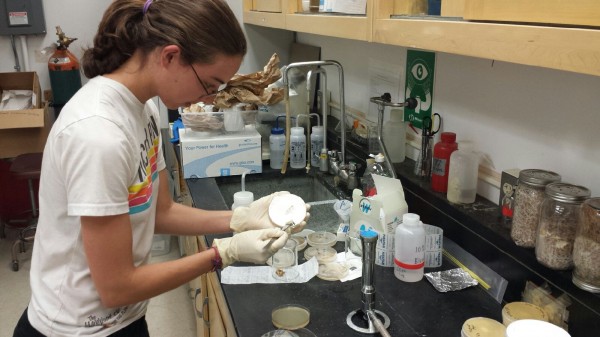UAF student tests mushrooms' cleaning power
July 14, 2014

Nancy Tarnai
907-474-5042
7/11/14
During early childhood in the Death Valley National Park, Christin Anderson found her passion for fungi at the local library.
With nary a mushroom alive in the desert environment, Anderson discovered a library book called “Mushrooms and Toadstools” when she was 6 years old. The colorful representations of fungi were all it took to hook her for life on mycology.
Anderson is working on a master’s degree in natural resources management at the University of Alaska Fairbanks under the tutelage of Mary Beth Leigh, Glenn Juday, David Valentine and Gary Laursen. “I have a great committee,” Anderson said.
Fascinated by the biology of fungi, Anderson explained that the mushroom is the fruit of the mycelium, a network of threadlike cells. Fungi cannot make their own food, so they either feast on dead organic matter, obtain energy by preying on living organisms or trade symbiotically with plants.
Mushrooms feast on plants, parasites and decaying wood. Anderson is focusing her research on the decaying wood types. “If they can degrade lignins, maybe they can degrade hydrocarbons like oil,” she theorized.
Anderson is experimenting with diesel-contaminated soil from Kaltag to see if the fungi will break down the fuel; she will try the methods at varying temperatures.
Soil remediation is an expensive process. “If I can find an in situ remediation method, it would be more affordable,” Anderson said. “Why not the non-toxic, natural mushroom?”
One advantage of this process is that it works quickly and can break down contaminated soil in a matter of weeks. Anderson has studied the writing of Paul Stamets (fungi.com) and hopes to meet him if she gets to attend the North American Mycological Association meeting in October in Washington state.
“Christin is the very definition of a self-starter, and a great example of a student who is clearly motivated by sheer curiosity, the simple desire to find out stuff," said Juday. "When she completely reoriented her M.S. to a new field of study — the potential use of fungi in bioremediation of diesel fuel spills in Alaska villages — I assumed there would be a significant amount of lag time as she got up to speed on a new topic. That was not the case."
Anderson has served as a mentor for Rural Alaska Honors Institute students this summer and is a natural resources technician for the Fairbanks Soil and Water Conservation District. She will assist Laursen on weekend mycological field trips to Denali National Park and the Kenai Peninsula. Her talk for the American Microbiology Society's Alaska branch meeting in Denali National Park in May was voted "best student presentation."
Anderson hopes to visit Kaltag and implement her methods in the field, once her lab work is perfected.
The Oberlin College graduate has her eye on a career in conservation. At UAF, she is involved in the Sustainable Campus Action Force and successfully implemented the idea of creating a campus “free store” where people can donate items or take them for free. It debuts this fall on the second floor of the Lola Tilly Commons.
When not researching or working, Anderson enjoys spending time on the dance floor. “I absolutely love dancing,” she said. “Swing is my favorite, but I also love contra dancing, salsa and tango.”
Wherever the future takes Anderson, mushrooms are likely to be a part of the story. And, yes, she loves to eat them in addition to studying them. Her favorite? King bolete, commonly known as the “penny bun.”


